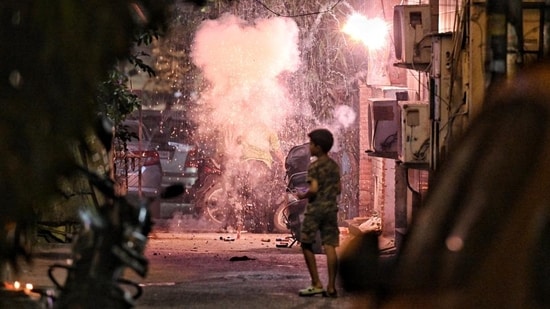Our Terms & Conditions | Our Privacy Policy
Delhi’s air quality takes a nosedive: Check AQI in your area | Latest News India
Delhi’s air quality worsened, staying in the ‘very poor’ category on Diwali, with levels expected to reach ‘severe’ due to nighttime firecracker use.
Children burst crackers on the eve of Diwali at Old Rajendra Nagar in New Delhi on Wednesday. (Sanchit Khanna/HT photo)(HT_PRINT)
The national capital’s 24-hour average air quality index (AQI) reached 328 at 4 pm, up from 307 on Wednesday, when Chhoti Diwali was celebrated.
Delhi saw clearer skies and brighter weather on Diwali in 2023, with an AQI of 218, showing improvement from levels in past years—312 in 2022, 382 in 2021 and higher figures before that, according to Central Pollution Control Board data.
Continuing the trend of the past four years, Delhi has implemented a complete ban on the manufacture, storage, sale, and use of firecrackers in the city.
Here are the details of polluted areas in Delhi
At 10 pm, the Central Pollution Control Board data showed that air quality across several areas of Delhi was very poor and moving towards the severe category with rise in pollutants.
The average air quality index (AQI) was 318 in Alipur, 393 in Anand Vihar, 359 in Ashok Vihar, 324 in Aya Nagar, 366 in Bawana, 339 in IGI Terminal T3 , 382 in RK Puram, 357 in Dwarka, 371 in Jahangirpuri, 340 in North Campus DU and 380 in Punjabi Bagh.
Meanwhile, the air quality in ITO was recorded at 289, Lodhi Road at 297, DTU at 265, placing these areas in the ‘poor’ category.
The average air quality index in the adjoining areas of the national capital, including Noida, Greater Noida, Gurugram, and Ghaziabad, was slightly better, with levels recorded in the “poor” category.
Specifically, Noida recorded an AQI of 281, Greater Noida at 251, Gurugram at 300, and Ghaziabad at 265.
Earlier, Delhi environment minister Gopal Rai had said that 377 teams have been formed to enforce the ban on firecrackers throughout the city.
He had mentioned that authorities were coordinating with resident welfare associations (RWAs), market associations, and social organisations to raise awareness about the ban.
The Central Pollution Control Board (CPCB) classes the air quality index between 0-50 as “good”, between 51 and 100 as “satisfactory”, between 101 and 200 as “moderate”, between 201 and 300 as “poor”, between 301 and 400 as “very poor”, and over 400 as “severe”.
Images are for reference only.Images and contents gathered automatic from google or 3rd party sources.All rights on the images and contents are with their legal original owners.



Comments are closed.